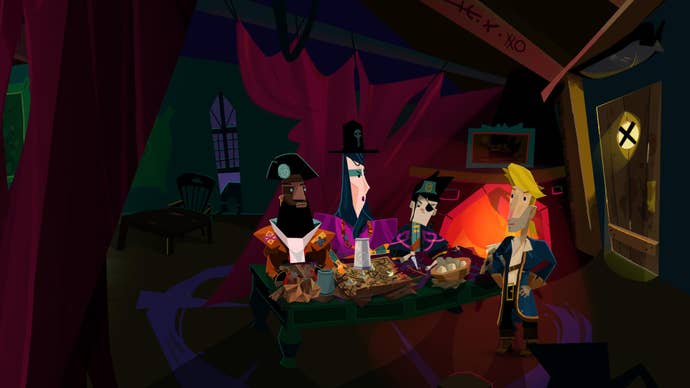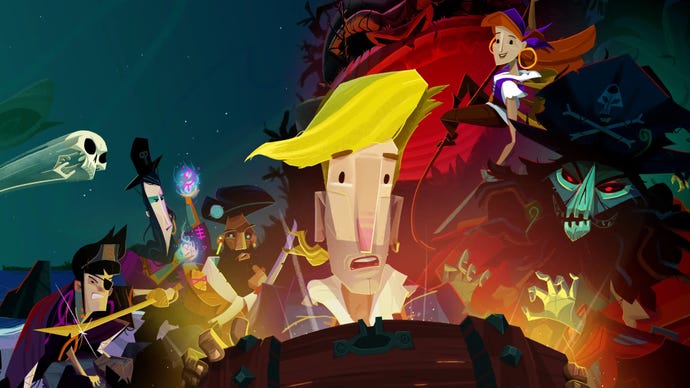Return to Monkey Island review: a charming nostalgia-ridden musing on the ravages of time – and a worthy successor
The creator of the Monkey Island series returns to offer his vision of a third game – and it’s got more to say than its nostalgic trappings first suggest.
Return to Monkey Island has a lot of tricks up its sleeve. The greatest trick it manages to play, however, is to pick up where Monkey Island 2 left off, 30 years prior, and do so while feeling entirely natural. Not a beat is missed, not a shred of strange discomfort. It just works. Older players will slide into this game’s embrace like an old, battered sofa. And it feels like home.
It has other tricks, however. Return to Monkey Island isn’t the third Monkey Island game in truth, of course – but it’s the third from series creator Ron Gilbert. Return has things to say about the canon of the series, given this presents itself as the third Monkey Island game despite being the sixth to actually hit store shelves.
There’s a neat subtext throughout about what stories really mean to us all. The decades between Monkey Island 2 and this new story has clearly given Gilbert time to reflect on the originals, the games which are likely to headline his epitaph regardless of what he does in the future – and the end result is fascinating and heartening.
Not everything from the other sequels has been tossed out. There’s nods, and even returning characters, from those games. They join a cast of returning characters that’ll fill Monkey Island veterans with glee, and a story that is a pretty straightforward race against Captain LeChuck to uncover the long-hidden, much-debated, real Secret of Monkey Island.
.jpg?width=690&quality=70&format=jpg&auto=webp)
Honestly, I don’t want to get into the story stuff. It’s so much of the charm and meat of these games, after all – and most interestingly, Return to Monkey Island is a game that actually has a thing or two to say. It’s not just a light-hearted, swashbuckling adventure that sees beloved protagonist (still voiced brilliantly by Dominic Armato, who puts in one of the most quietly iconic performances in games history) Guybrush Threepwood return to familiar locations. It’s more than that. Even when the adventure is tugging you along on a little nostalgia tour, the world itself has changed, its inhabitants and status shifted by the unrelenting passage of time.
The actual game part is relatively unchanged from the classics – it’s a point-and-click adventure game. It’s drag-and-drop, item-combining, brain-teasing puzzles of environment and narrative strung together by delightfully sharp writing and tight delivery. You’ll spend plenty of time scrutinizing your inventory and combing through optional dialogue options in order to pinpoint what exactly you need to do to get to the next location required.
Quite often you know where you need to go, as is traditionally the case with this genre, but the puzzle is in figuring out how to open the required doors or obtain the necessary items to get there. There’s usually a gentle trickle to your inventory – one item leads to another, and another, the dominoes of conundrum toppling one-by-one. When this genre is at its best, it can make you feel like you’re an Einstein-level genius just for putting two-and-two together, and Return to Monkey Island has that.
.jpg?width=690&quality=70&format=jpg&auto=webp)
Changes and evolutions to the genre over the years have of course been integrated here; it’s a friendlier experience, and one where it’s easier to experiment than veterans will be used to. It’s easier to see what any given item might be capable of doing thanks to little dialogue barks from Guybrush and other visual cues. There’s even a hint book and a straight-up a To-Do list, which works like a little quest log, helping to ensure you don’t forget any one of the many narrative and puzzle plates you’re currently spinning.
For newcomers this is a huge improvement, and pairs with a canny story delivery and a few features that act as an in-universe ‘previously on’ to ensure all, even those who haven’t touched the originals for 20 years or those who have never played them at all, can get on with this experience. Despite this, Return is unashamedly first and foremost for people Gilbert knows – people whose lives and formative years are steeped in the earlier adventures of Threepwood. Nostalgia can very easily tip over from fun into cringe – Star Wars has been unable to retain the balance of late, for instance – but Return to Monkey Island walks that tightrope brilliantly.
Puzzles themselves continue teh genre tradition of oscillating between relative simplicity and obtuse to the point of silliness - though at least here, you have the hint book to help you. Even so, it does feel like this is another adventure game that struggles to quite touch perfection thanks to a struggle to really stick the landing on all of the puzzle design. The iffier bits are quickly enough forgotten, however.
.jpg?width=690&quality=70&format=jpg&auto=webp)
The biggest thing that’s truly different about the game is its visual style, and this was predictably the thing that some fans got most up in arms about when it was revealed. But, you know what? I like it. I didn’t like it at first, but it grew on me. The most important thing is that its characters have the power to emote and to sell that story. Yes, this exaggerated puppet-like look with characters who could’ve been built from craft paper is slightly uncanny – but it really works.
Or at least, it works for me. I suspect this one will be deeply subjective, which is fine. I can also see the argument that potentially a full-blown throwback game, with pixel art, would’ve been even more appropriate. The artistry in this design cannot be denied, though, and I actually think the artistic switch-up brings something to some of the points the game is trying to make.
Return to Monkey Island has a lot of tricks. It plays with nostalgia, with expectation, and with a user’s understanding of previous works. It needles at new ideas, and weaves them in with the old with a delicate artistry. Video games are created by huge teams, and to attribute any game to one person is a folly - but at the same time, it’s undeniable that Return feels like a deeply personal game to Ron Gilbert, the originator of this series.

In that, it feels like the rare auteur-driven game – where it’s not just self-aware fun, but also a piece of art with something to say about the past, the present – and even how our changing understanding of ourselves, and our stories, can color the future. It’s brilliant, and exactly what I hoped it would be.


